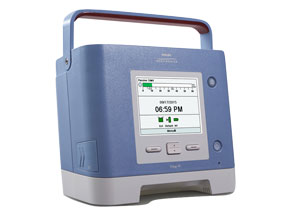
A ventilator, also known as a mechanical ventilator, is a medical device designed to provide respiratory support to patients who are unable to breathe adequately on their own. Ventilators are critical in intensive care units (ICUs), operating rooms, and during emergency situations. They are used for various medical conditions that impair normal breathing. We are leading service provider of Ventilator Machine On Rent in Mumbai.
How Ventilators Work
Ventilators function by delivering air, usually with extra oxygen, into the lungs and removing carbon dioxide from the body. They can provide fully controlled breaths or assist the patient’s own breathing efforts. Here’s a simplified process of how ventilators operate:
- Air Delivery:
- Air (with or without additional oxygen) is delivered to the patient’s lungs through a breathing tube (endotracheal tube or tracheostomy tube).
- Pressure and Volume Control:
- Ventilators can control the pressure and volume of air delivered to ensure the lungs receive adequate ventilation without causing damage.
- Monitoring and Adjustments:
- Continuous monitoring of the patient’s respiratory parameters allows for adjustments to the ventilator settings to match the patient’s needs.
Types of Ventilators
- Invasive Ventilators:
- These require insertion of a breathing tube into the patient’s airway (endotracheal intubation or tracheostomy).
- Used for patients with severe respiratory failure or during surgery.
- Non-Invasive Ventilators:
- These use a mask or similar interface to deliver air without the need for a tube.
- Commonly used for less severe respiratory issues or in cases where intubation is not possible or necessary.
Uses of Ventilator Machines
Ventilators are employed in various medical scenarios, including:
- Acute Respiratory Distress Syndrome (ARDS):
- Severe lung condition requiring mechanical ventilation to ensure sufficient oxygenation.
- Chronic Obstructive Pulmonary Disease (COPD):
- Patients with advanced COPD may need ventilatory support during exacerbations.
- Pneumonia:
- Severe pneumonia can impair breathing, necessitating mechanical ventilation.
- COVID-19:
- In severe cases of COVID-19, ventilators are used to manage respiratory failure.
- Surgical Procedures:
- Anesthesia and certain surgeries require controlled ventilation.
- Traumatic Injuries:
- Injuries affecting the respiratory system may require mechanical ventilation for support.
- Neuromuscular Disorders:
- Conditions like ALS, muscular dystrophy, or spinal cord injuries that affect breathing muscles may require ventilatory assistance.
Key Features of Ventilators
- Modes of Ventilation:
- Various modes, such as Assist-Control (AC), Synchronized Intermittent Mandatory Ventilation (SIMV), and Continuous Positive Airway Pressure (CPAP), cater to different patient needs.
- Alarms and Safety Features:
- Ventilators have alarms to alert healthcare providers to issues like disconnection, high pressure, or low oxygen levels.
- Oxygen Control:
- Precise control over the oxygen concentration delivered to the patient.
- Patient Monitoring:
- Integrated systems to monitor vital respiratory parameters such as tidal volume, respiratory rate, and oxygen saturation.
- Humidification:
- Ensures that the air delivered is appropriately humidified to prevent drying out of the airway mucosa.
Benefits of Using Ventilators
- Life-Saving Support:
- Critical in saving lives by ensuring patients receive adequate oxygenation and ventilation.
- Stabilization:
- Helps stabilize patients during severe respiratory conditions or post-surgery recovery.
- Improved Outcomes:
- Proper ventilation can improve the outcomes for patients with severe respiratory conditions.
Conclusion
Ventilators are indispensable tools in modern medicine, providing critical respiratory support for a wide range of conditions. Understanding their functionality, types, and uses can help in appreciating their vital role in patient care and management.

